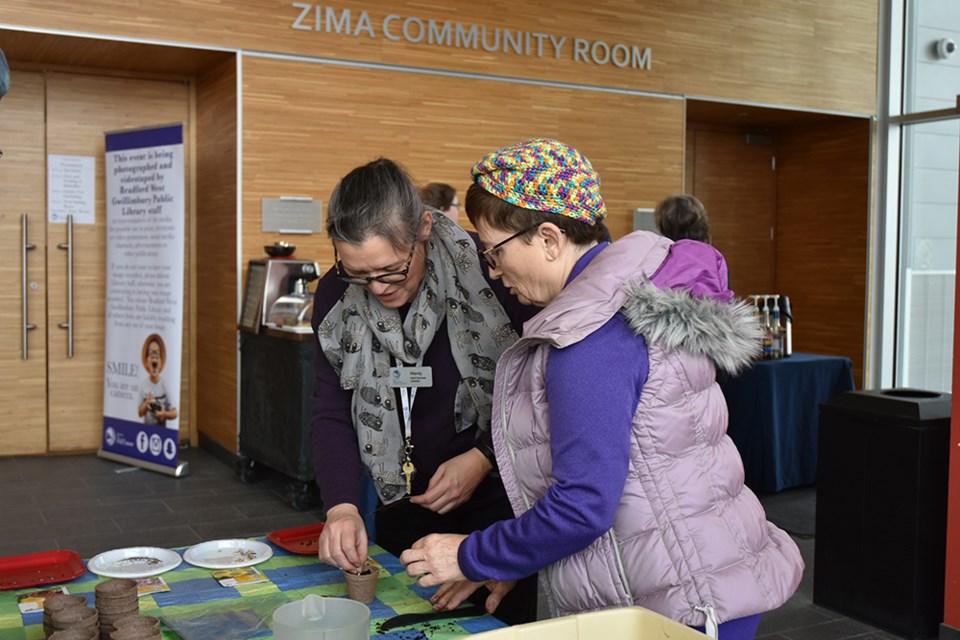From the Brown Marmorated Stink Bug, just the latest invasive species to show up in Ontario, to tips on how to plant a “Square Foot” Garden, the first-ever Seedy Saturday at the Bradford Library offered a wide range of activities, demonstrations and workshops for anyone interested in gardening, or nature.
Visitors could browse the Vendors’ booths in the Atrium, ask questions of the Lake Simcoe South Master Gardeners in the lobby, and listen to guest speakers in the Zima Room.
There were opportunities to participate in a community seed swap, and support the new BWG Seed Library – a “library” that allows gardeners to sign out seeds at the start of the growing season, and then collect and “return” the seeds at harvest-time.
There were even garden-related crafts for kids, who could create a terrarium filled with plants in the Library’s Green Room, or plant a sunflower in a peat pot, at the Bond Head-Bradford Garden Club booth, to take home.
Cathy Nikolaidis, at the Lake Simcoe South Master Gardeners’ booth, was sounding an alarm about the Brown Marmorated Stink Bug. Unlike native species, which feed on pest caterpillars and are beneficial, the invasive species poses a serious threat.
“It can decimate a crop,” said Nikolaidis – attacking everything from berries and fruit trees, to grapes, asparagus, tomatoes, corn, soy, beans and ornamental shrubs. Even more alarming, the invasive has been spotted in the Hamilton area, close to the Niagara escarpment.
“They can move, be carried inadvertently,” she said, urging gardeners to become familiar with the broad shield shape and distinctive diamond pattern of the invasive stink bug – and to trap and report sightings to either the master gardeners, at lss.mgoi.ca or Ontario ministry of agriculture, food and rural affairs.
Other booths encouraged visitors to plant native species, go organic, try vermicomposting and sprouting, or purchase hand-crafted soaps – like those created by Lim Comsa, of ‘Pure Botanicals.’
Planning to pursue a career in conservation biology, Comsa saw soap-making as an extension of that interest. “It’s kind of our way of sharing that with people,” Comsa said, noting that while “a lot of soaps today have palm oil, and a lot of other stuff that isn’t natural,” Pure Botanicals’ soaps are made with only organic olive and coconut oils, essential oils, and natural ingredients like red clay, black charcoal, and “lavender buds from our own garden.”
Guest speakers included Eleonora Schmeid, promoting succulents as the perfect plants for a world facing climate change, and increasing likelihood of periods of drought in summer.
Succulents are pre-adapted, she said, noting, “It’s so important to make people aware of it. The leaves and the stems are water storage systems. They can go a long time without water – they’re very forgiving plants.”
Schmeid planted the succulents, from Sedums to cacti, in a variety of containers, on old logs, even in old high-heeled shoes, to create mini-gardens that featured subtle shades and textures. The “shoe planters,” Schmeid said, were mostly put together as “gifts for girlfriends,” or as part of a fun workshop for women.
“Butterfly Lady” Maria da Costa provided advice on how to plant a Pollinator Garden, to attract butterflies and moths – dill to host Black Swallowtails, Pearly Everlasting for American Lady butterflies, native milkweed for Monarchs – and how to raise caterpillars, to be released as butterflies back into the wild.
Da Costa said she began raising butterflies because of her children. Her daughter - “She’s 21 now.” – was fascinated with nature, and brought “everything home,” including a caterpillar of what turned out to be a gypsy moth. Watching the metamorphosis from caterpillar to cocoon to moth, sparked a life-long passion.
Last year, Da Costa personally released 300 monarchs to the wild – and gave away “hundreds and hundreds of eggs,” along with how-to instructions, to others, so that they could share the joy and the excitement of a butterfly release. Her Pollinator Gardens on facebook.com offers further tips on turning backyards into havens for butterflies, bees and hummingbirds.
Master Gardener Kathleen Gorsline shared the secrets of Square Foot Gardening, planning and planting to maximize yields in a small space.
Mulch, compost, a good manure, and healthy mycorrhizal flora within the soil – the fungal network that not only makes nutrients available to plants, but allows the roots to “communicate” – are key to good soils and a successful harvest, said Gorsline.
She also identified the science behind the tradition of waiting until the “May 24 weekend” to plant, in this area; it has nothing to do with Queen Victoria, and everything to do with the last frost of winter.
As for lunar planting, she said, “Believe it or not your soil will hold moisture better,” if planting takes place 2 days before a full moon.
Gorsline also recommended companion planting – including the use of marigolds to drive away pests – and described the variety and abundance that can result from careful planting of a space measuring only 1.2 metres by 1.2 metres.
Time it right, and by the time an early crop like radish is ready to harvest, the weather will be warm enough to replant with peppers and eggplant – and then again, in the fall, with a fast-growing cool weather crop.
“Even in a square foot, you can get three crops,” Gorsline said. “It’s a less complicated method of gardening, but it’s so successful!”
Gardening tips, crafts, vendors, an opportunity to participate in the Seed Library – Seedy Saturday was a perfect opportunity to plan a summer garden, even as winter returned outside, covering the ground with snow.



